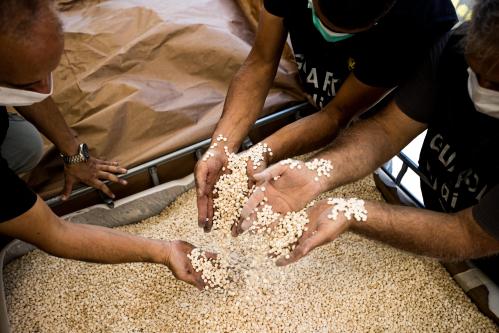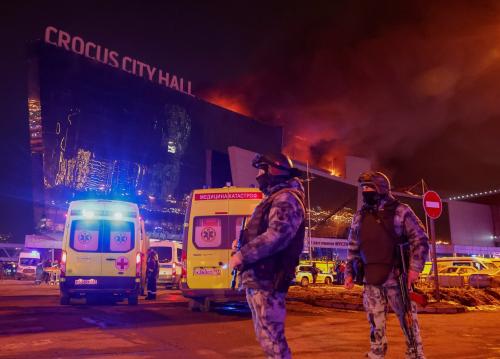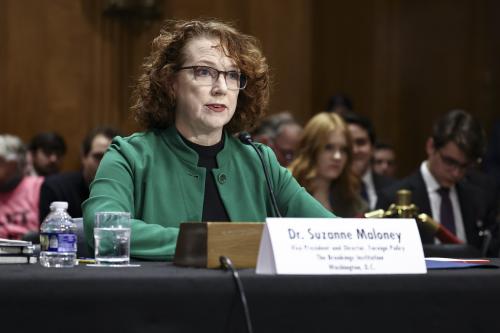Will McCants: As we continue onwards in the so-called Long War, it’s a good time to reflect on where we are in the fight against al-Qaida and its bête noire, the Islamic State. Both organizations have benefited from the chaos unleashed by the Arab Spring uprisings but they have taken different paths. Will those paths converge again or will the two organizations continue to remain at odds? Who has the best strategy at the moment? And what political changes might happen in the coming year that will reconfigure their rivalry for leadership of the global jihad?
To answer these questions, I’ve asked some of the leading experts on the two organizations to weigh in. First was Barak Mendelsohn, who analyzed the factors that explain the resilience and weaknesses of both groups. Then Clint Watts offered ways to avoid the flawed assumptions that have led to mistaken counterterrorism forecasts in recent years.
Next up is Charles Lister, a resident fellow at the Middle East Institute, to examine the respective courses each group has charted to date and whether that’s likely to change.
Charles Lister: The world of international jihad has had a turbulent few years, and only now is the dust beginning to settle. The emergence of the Islamic State as an independent transnational jihadi rival to al-Qaida sparked a competitive dynamic. That has heightened the threat of attacks in the West and intensified the need for both movements to demonstrate their value on local battlefields. Having spent trillions of dollars pushing back al-Qaida in Afghanistan and Pakistan and al-Qaida in Iraq, the jihadi threat we face today far eclipses that seen in 2000 and 2001.
As has been the case for some time, al-Qaida is no longer a grand transnational movement, but rather a loose network of semi-independent armed groups dispersed around the world. Although al-Qaida’s central leadership appears to be increasingly cut off from the world, frequently taking many weeks to respond publicly to significant events, its word remains strong within its affiliates. For example, a secret letter from al-Qaida leader Ayman al-Zawahiri to his Syrian affiliate the Nusra Front in early 2015 promptly caused the group to cease plotting attacks abroad.
Seeking rapid and visible results, ISIS worries little about taking the time to win popular acceptance and instead controls territory through force.
While the eruption of the Arab Spring in 2010 challenged al-Qaida’s insistence that only violent jihad can secure political change, the subsequent repression and resulting instability provided an opportunity. What followed was a period of extraordinary strategic review. Beginning with Ansar al-Sharia in Yemen (in 2010 and 2011) and then with al-Qaida in the Islamic Maghreb (AQIM), Ansar al-Din, and the Movement for Unity and Jihad in West Africa (MUJAO) in Mali (2012), al-Qaida began developing a new strategy focused on slowly nurturing unstable and vulnerable societies into hosts for an al-Qaida Islamic state. Although a premature imposition of harsh Shariah norms caused projects in Yemen and Mali to fail, al-Qaida’s activities in Syria and Yemen today look to have perfected the new “long game” approach.
In Syria and Yemen, al-Qaida has taken advantage of weak states suffering from acute socio-political instability in order to embed itself within popular revolutionary movements. Through a consciously managed process of “controlled pragmatism,” al-Qaida has successfully integrated its fighters into broader dynamics that, with additional manipulation, look all but intractable. Through a temporary renunciation of Islamic hudud (fixed punishments in the Quran and Hadith) and an overt insistence on multilateral populist action, al-Qaida has begun socializing entire communities into accepting its role within their revolutionary societies. With durable roots in these operational zones—“safe bases,” as Zawahiri calls them—al-Qaida hopes one day to proclaim durable Islamic emirates as individual components of an eventual caliphate.
Breadth versus depth
The Islamic State (or ISIS), on the other hand, has emerged as al-Qaida’s obstreperous and brutally rebellious younger sibling. Seeking rapid and visible results, ISIS worries little about taking the time to win popular acceptance and instead controls territory through force and psychological intimidation. As a militarily capable and administratively accomplished organization, ISIS has acquired a strong stranglehold over parts of Iraq and Syria—like Raqqa, Deir el-Zour, and Mosul—but its roots are shallow at best elsewhere in both countries. With effective and representative local partners, the U.S.-led coalition can and will eventually take back much of ISIS’s territory, but evidence thus far suggests progress will be slow.
Meanwhile, ISIS has developed invaluable strategic depth elsewhere in the world, through its acquisition of affiliates—or additional “states” for its Caliphate—in Yemen, Libya, Algeria, Egypt, Afghanistan, Pakistan, Nigeria, and Russia. Although it will struggle to expand much beyond its current geographical reach, the growing importance of ISIS in Libya, Egypt, and Afghanistan-Pakistan in particular will allow the movement to survive pressures it faces in Syria and Iraq.
As that pressure heightens, ISIS will seek to delegate some level of power to its international affiliates, while actively encouraging retaliatory attacks—both centrally directed and more broadly inspired—against high-profile Western targets. Instability breeds opportunity for groups like ISIS, so we should also expect it to exploit the fact that refugee flows from Syria towards Europe in 2016 look set to dramatically eclipse those seen in 2015.
Instability breeds opportunity for groups like ISIS.
Charting a new course?
That the world now faces threats from two major transnational jihadist movements employing discernibly different strategies makes today’s counterterrorism challenge much more difficult. The dramatic expansion of ISIS and its captivation of the world’s media attention has encouraged a U.S.-led obsession with an organization that has minimal roots into conflict-ridden societies. Meanwhile the West has become distracted from its long-time enemy al-Qaida, which has now grown deep roots in places like Syria and Yemen. Al-Qaida has not disappeared, and neither has it been defeated. We continue this policy imbalance at our peril.
In recent discussions with Islamist sources in Syria, I’ve heard that al-Qaida may be further adapting its long-game strategy. The Nusra Front has been engaged in six weeks of on/off secret talks with at least eight moderate Islamist rebel groups, after proposing a grand merger with any interested party in early January. Although talks briefly came to a close in mid-January over the troublesome issue of the Nusra Front’s allegiance to al-Qaida, the group’s leader Abu Mohammed al-Jolani now placed those ties as an issue on the table for negotiation.
Al-Qaida has not disappeared, and neither has it been defeated.
The fact that this sensitive subject is now reportedly open for discussion is a significant indicator of how far the Nusra Front is willing to stretch its jihadist mores for the sake of integration in Syrian revolutionary dynamics. However, the al-Nusra Front’s leader, Abu Mohammed al-Jolani, is a long-time Al-Qaeda loyalist and doesn’t fit the profile of someone willing to break a religious oath purely for the sake of an opportunistic power play. It is therefore interesting that this secret debate inside Syria comes amid whispers within Salafi-jihadi and pro-al-Qaida circles that Zawahiri is considering “releasing” his affiliates from their loyalty pledges in order to transform al-Qaida into an organic network of locally-inspired movements—led by and loosely tied together by an overarching strategic idea.
Whether al-Qaida and its affiliates ultimately evolve along this path or not, the threat they pose to local, regional, and international security is clear. When compounded by ISIS’s determination to continue expanding and to conduct more frequent and more deadly attacks abroad, jihadist militancy looks well-placed to pose an ever present danger for many years to come.



Commentary
Experts Weigh In (part 3): What is the future of al-Qaida and the Islamic State?
February 24, 2016